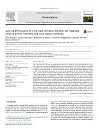The performance of a full-scale riverbank filtration facility in Colorado was evaluated from initial start-up over a period of seven years including the impact of seasonal variations to determine whether sustainable attenuation of various chemical constituents could be achieved. Both, annual and seasonal average concentrations were determined for several wastewater-derived constituents including dissolved organic carbon (DOC), ultraviolet absorbance at 254 nm, nitrate, phosphate for the years 2006, 2009, 2010, 2012, and trace organic chemicals (TOrC) for years 2009, 2010, and 2012. ANOVA analyses and Student’s t-tests were performed to evaluate the consistency of contaminant attenuation at the site. Findings revealed no significant statistical differences for any of the bulk parameters with the exception of phosphate suggesting a highly reliable attenuation of DOC and nitrate from start-up to full-scale performance. Phosphate attenuation, however, exhibited a steady decline, which was likely attributed to exhaustion of sorption sites in the subsurface porous media. The river’s flow regime influenced both occurrence levels and attenuation of TOrC during riverbank filtration, i.e. less river discharge resulted in higher TOrC concentrations and lower proportion of river water in the recovered groundwater. Differences in removal performance between annual data sets for caffeine, trimethoprim, sulfamethoxazole, and carbamazepine were caused by variations in the source; concentrations in riverbank filtrate remained similar over several years. The seasonal assessment for TOrC revealed steady or improving removal between winter and summer seasons based on the statistical analysis with atenolol being the only exception likely due to an increased microbial activity at elevated temperatures.
